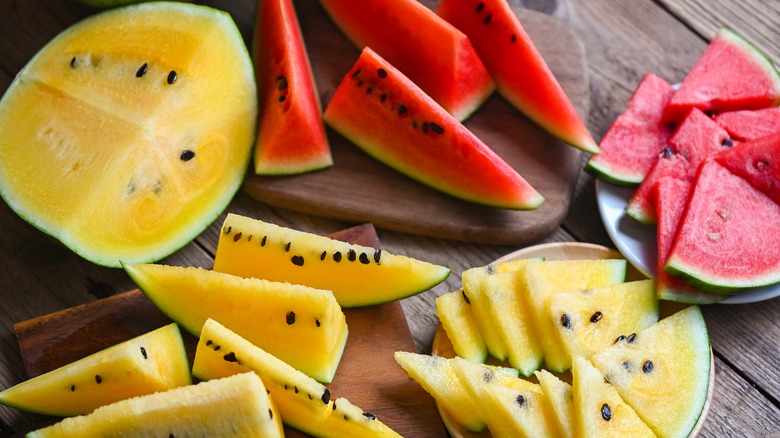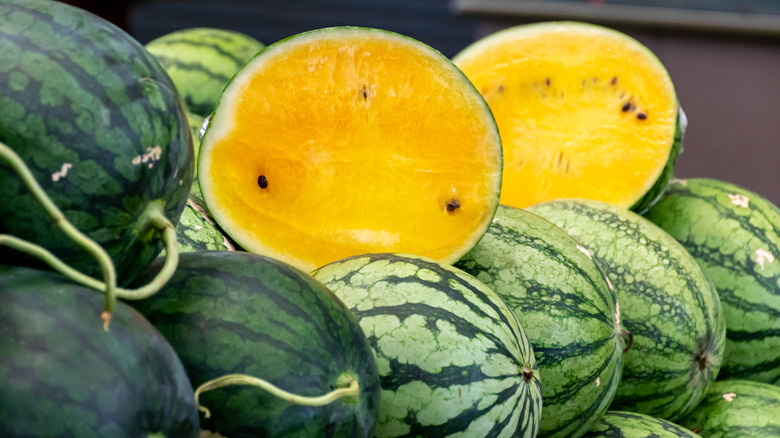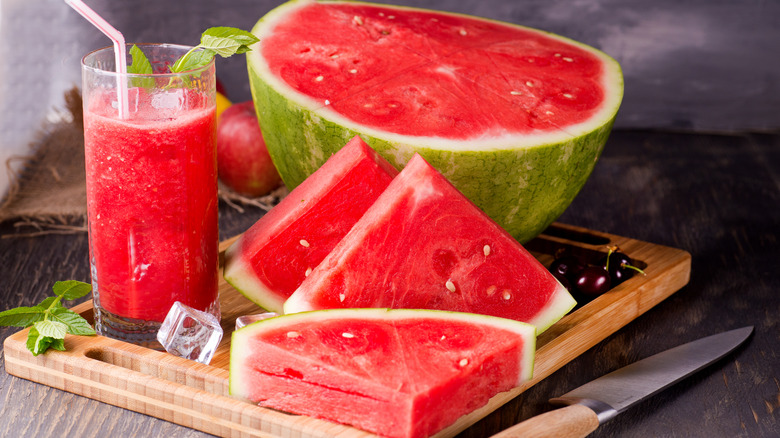Red Versus Yellow Watermelons: What Sets Them Apart?
When you think of a watermelon, it's the oblong fruit with dark or stripey green skin and juicy red flesh that most often comes to mind — the same fruit that's a quintessential part of cookouts, picnics, and all things summer. But not all watermelons are identical in size or shape, nor do they all have reddish-pink flesh. In fact, some varieties will reveal a sunny yellow pulp when sliced into!
Known as yellow watermelons, these lemon-colored fruits look much the same as their red counterparts from the outside, and have near-identical stripey green rinds. Both can have similar brownish-black or white seeds, or can be entirely seedless. The most significant distinction between red and yellow watermelons comes from the pigments they contain, which gives each of the two melons its own distinct tint. Red watermelons are packed with the antioxidant lycopene, which is the same pigment that gives fruits like tomatoes and grapefruits their ruby shade. On the flip side, yellow watermelons get their color from beta-carotene — the antioxidant responsible for the orange-yellow hue of pumpkins and sweet potatoes.
The difference in antioxidants also means there are certain nutritional differences between red and yellow watermelons. But that's not all: The two types of watermelon also differ in terms of taste.
The history of red and yellow watermelons
Yellow watermelons are often mistakenly thought to be the result of genetic modification, but that's far from the truth. Recent discoveries indicate that all watermelons are descendants of a very hard and bitter fruit, which is why ancient people hated the taste of watermelon. It was only after years of careful cultivation and selective breeding that a change was brought in the melon's color, texture, and flavor. An Israeli Byzantine mosaic from A.D. 425 indicates that watermelons at the time had developed a yellow-orange hue, and it was only through further breeding that the golden tint transitioned to red.
The roots of yellow watermelons can also be traced back to Africa, where they've been cultivated for over 5,000 years. The fruit's high water content and its ability to thrive in hot climates made it an invaluable source of hydration in ancient Egypt and Africa, which is why Africans sometimes refer to them as "desert kings." As such, the yellow versions are among the oldest varieties of watermelon, and have been around for much longer than their red counterparts.
This also means that the two fruits have different flavor profiles. While red watermelons have a bit of tang and a succulent texture, their yellow counterparts have denser flesh and a more subdued flavor, but are a touch sweeter in comparison. Some varieties of yellow watermelons are even more saccharine, and have a flavor that's reminiscent of apricots and honey.
There are different varieties of red and yellow watermelons
The exact difference in the flavor of the two summer fruits will depend on their variety. For instance, Crimson Sweet — a type of red watermelon — is renowned for its syrupy, honey-like flavor, and is considered one of the sweetest of its kind. However, its lemony counterpart, Yellow Crimson, is even more saccharine. Buttercup Yellow is another variety of the sunny watermelon, though it has a dense and seedless flesh. It is also remarkably high in sugar, making it one of the sweetest and most popular varieties of yellow watermelon.
The gold-tinted Yellow Doll is similar to a Red Sugar Baby or Icebox watermelon. Both are small in size, grow quicker than most other varieties of watermelons, and pack a sweet punch. Another variety is the Yellow Flesh Black Diamond, which is one of the least sweet types of yellow watermelon, and closest to its red counterparts in terms of sugariness.
Regardless of the subtle variations in their flavor, however, both red and yellow watermelons are cut, chopped, and prepped the same way. They can also be used interchangeably in recipes, including in smoothies, salads, frozen desserts, cocktails, and savory dishes. However, yellow watermelons do have a slightly sweeter taste which can be more appealing in certain recipes, and their flavor pairs fabulously with acid and spice in dishes like salsa. In fact, the two types of watermelon can even be swapped into your favorite tomato salsa for a refreshing twist.



